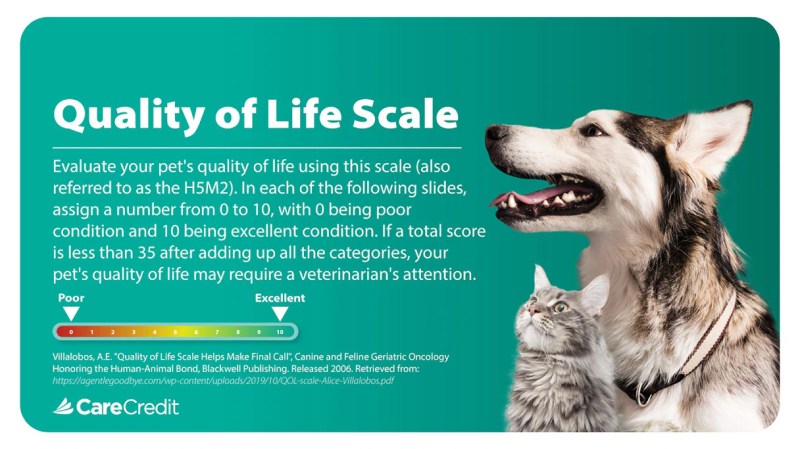When Do You Know To Put Your Dog Down – As pet parents, we all fear losing our beloved canine companion. Many dogs age gracefully without serious health problems, but others suffer from chronic, debilitating or terminal illnesses that reduce their quality of life. Inevitably, we make our partner feel like their time with us is coming to an end.
One of the biggest questions pet parents face is whether or not the time is right: too soon? Other pet owners wonder if they can euthanize their pet “naturally” at home without medical intervention. Pet owners hope that this situation plays out peacefully and that their dog dies peacefully in his sleep.
When Do You Know To Put Your Dog Down

But the reality is that natural death is usually not peaceful, and terminally ill dogs can experience days of agony, nausea, and anxiety as their bodies begin to shut down. Therefore, this standard requires veterinarians to provide humane, painless euthanasia to end the suffering of pets.
Understanding Aggression In Dogs: Signs Your Dog Has Aggression Issues — Ancillary K9 Dog Training
There are many clinical signs that can indicate that a dog is beginning to decline toward death. However, these symptoms can be vague indicators of other non-terminal health problems, so if you notice a change or deterioration in your dog’s health or daily routine, he should be examined periodically by a veterinary team.
Changes may develop as early as three months before death. These changes can be physical or dynamic:
If you’re looking for signs that it’s time to talk about euthanasia, these questions can help you determine your dog’s quality of life:
If the answer to these questions is no, it may be time to consider end-of-life care for your dog. Options include hospice or palliative care, euthanasia (at home or in a hospital), and discussion about how you would like to memorialize your dog after death.
What’s A Double Coated Dog And How Do You Care For All That Hair?
As with the previous questions, you can also use the Quality of Life Scale developed by Dr. Alice Villalobos to assess your dog’s overall physical and mental health. Scale parameters include:
Each “H” and “M” is scored on a scale of 1 to 10, with a total score of 35 or higher indicating that the dog still has an acceptable quality of life and that treatment may be beneficial. Scores less than 35 indicate an unacceptable quality of life and the dog may need to be considered for palliative care or euthanasia as soon as possible.
A natural death does not mean a peaceful death. Seeing the stages of death is very stressful. That is why euthanasia is used to ensure a humane and painless end for pets.

Otherwise, the animal’s breathing rate will continue to slow and dogs will make a “death rattle” in the chest as phlegm builds up in the throat. Your body temperature begins to drop and your extremities may feel cold to the touch.
Travelling With Pets? Here Are The Essentials You Need!
Dying dogs are generally unable to get up and go about their business, so pet owners should have disposable diapers and replaceable bedding to maintain proper hygiene and comfort. Dogs are usually not interested in eating or drinking at this time.
Final death occurs when the dog’s organs shut down, it stops breathing and the heart stops beating. After natural death, breathing and heartbeat stop for 30 minutes, pet owners can be sure that the dog has passed away.
After death, brief muscle contractions with muscle relaxation, final deep breaths, and loss of bladder and bowel control may occur. This can be disturbing to observe as the dog may be mistakenly believed to be alive, so it is important to understand that this can occur as part of a death.
Compared to the long and painful process of natural death, euthanasia has evolved to provide a less stressful experience for pet owners and a less traumatic experience for pets.
Dog Bite Prevention
At your euthanasia appointment, the veterinarian will insert an intravenous catheter into your dog’s vein to ensure that all injections are easily administered. Your dog may feel some discomfort when the catheter is inserted.
After placing the IV in the cat, the veterinarian will administer a sedative that will cause the dog to relax and enter a semi-conscious state. After that, a final euthanasia injection is administered, usually causing death within minutes. Your dog can stretch his entire body and breathe deeply. His pupils dilate, his breathing stops and his heart stops beating.
Veterinarians can confirm death by listening to the heartbeat, pulse and breathing. They may also gently touch the surface of the eye to make sure there is no blink reflex.

If you notice signs of deterioration in his health or evaluate his quality of life, take this information to your veterinarian to discuss your options. You may be told your dog can be euthanized or recommend palliative care or euthanasia sooner rather than later.
Children & Dogs
The goal of palliative care is to control pain and provide comfort in the declining stages of life. Although deworming is a viable alternative to more aggressive treatments, it may not be a realistic option for all pets. To see if this makes sense, you should consider these questions:
Try to be open to the idea of human effects after medications and other palliative interventions fail to maintain an acceptable quality of life for a terminally ill dog. Although this is a frightening prospect, many pet owners struggle with the question of whether or not this decision is a more humane and loving option for their pet’s death than choosing a natural death at home.
Dogs enter the final stages of death when their body systems fail, causing a buildup of toxins that the body cannot expel and, in some cases, severe nausea, vomiting, and seizures. The inevitable pain due to arthritis or new platelets can make even resting in one place unbearable, while making it difficult for the dog to get up, eat, drink, or go to the bathroom. Dyspnea and heart failure are not always painful, but both can cause tremendous anxiety in dogs who have difficulty breathing.
If your canine companion has reached a stage where his comfort and quality of life are failing, contact your veterinarian immediately to schedule an appointment for euthanasia. This appointment can be made at the clinic or at home, but decisions must be made quickly to avoid prolonging the dog’s suffering.
Should I Worry About This Lump On My Dog?
The best thing you can do for your dog in his final days is to make sure he is as comfortable as possible.
Be sure to maintain a clean, supportive bed (clay or peat moss) along with disposable pots, and avoid soil bed if dormancy is a problem. Some dogs can tolerate diapers, but you should change them regularly and keep their coat and skin free of urine and feces to avoid skin irritation or genital infections.
If your dog has a favorite blanket, toy, or clothing that smells like you, keep them nearby if you need to leave them unattended for a while. Spending as much time as possible with your dog will not only provide him with the emotional support he needs, but it will also help you detect signs of distress or anxiety.

If your dog tolerates it, continue taking all medications to reduce pain and anxiety. Some dogs that do not eat well may experience nausea when given stomach medications. Talk to your veterinarian about changing any medications to ensure they provide maximum relief. Dogs may also benefit from a mild sedative to help them sleep at night if they are restless.
How Do You Know If Your Dog Is In Pain?
As your dog’s final moments approach, you may feel conflicted about watching your friend pass away. No matter how difficult it is, knowing that their loving family is with them can be a great comfort to them.
Depending on the age of the child and the temperament of the other pets, a decision must be made whether children or other pets are allowed at the time of death.
Some experts believe that children and other pets should not be included in the final farewell, but others believe that seeing your companion in the moments after death can help bring closure and understanding to the pet’s home.
Dr. Leslie Gillette graduated from the University of Florida College of Veterinary Medicine in 1998. After 12 years as small animals… Dogs have always shown proverbial emotions: their entire bodies speak, from the expressive ears to the wild movement from the tail.
Signs A Dog Is Dying
We all understand very basic Kannada: sticking to the vehicle is a yes, growling and teething is a no. Second lesson! “Do you want to play?” What are you saying
You can catch your dog “bowing.”

